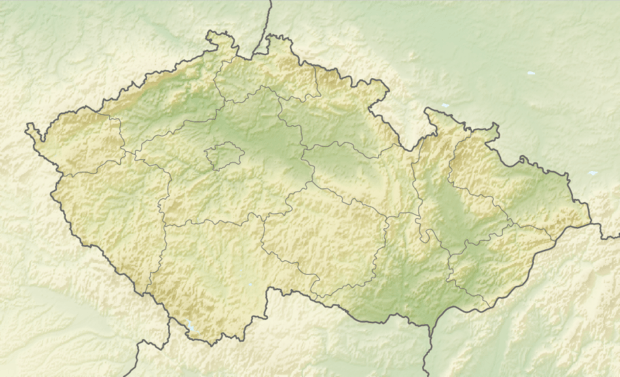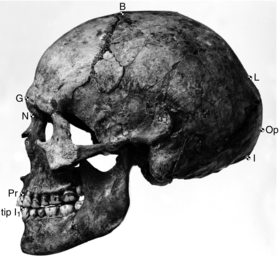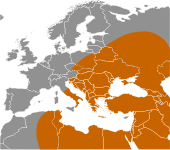Předmostí u Přerova (archeology)
| Předmostí u Přerova | |
|---|---|
| Archeological site | |
|
| |
| Highest point | |
| Elevation | 250 m (820 ft) |
| Prominence | 35 m (115 ft) |
| Coordinates | 49°27′56″N 17°26′23″E / 49.46556°N 17.43972°ECoordinates: 49°27′56″N 17°26′23″E / 49.46556°N 17.43972°E |
| Dimensions | |
| Area | 37 acres (15 ha) |
| Geography | |
 Předmostí u Přerova | |
| Location | Czech Republic—Moravia |
| Parent range | Moravian Gate/Oderské vrchy |
| Geology | |
| Age of rock | Late Pleistocene |
Předmostí (Skalka) (often without diacritics as Predmosti or Predmost), situated in the north western part of Přerov, Moravia near the city districts Předmostí of Přerov, is an important Late Pleistocene Cro-Magnon hill site of Central Europe.
A fossil site at Předmostí is located near Přerov in the country Moravia of what is today the Czech Republic. The site was discovered in the late 19th century. Excavations were conducted between 1884 and 1930. As the original material was lost. The skeletal remains of the few dozen people from Předmostí are among the most important finds ever made of anatomically modern humans, and are accompanied by items from the Gravetian culture. A major restriction on the opportunities available for extracting information from this Upper Paleolitic population assemble, however, came with the irreparable damage done to the skeletal material during fire at Mikulov castle in the course of World War II. For many years, the only sources of scientific information relating to the assemblage available were two - volume work by Jindřich Matiegka (1934 and 1938) and casts made of the skulls of individuals Předmostí 3 and Předmostí 4, and the endokrania of individuals Předmostí 3, 4, 9 and 101, in the collection of Moravian Museum in Brno.
New excavations were conducted.
The Předmostí site appears to have been a living area with associated burial ground with some 20 burials, including 15 complete human interments, and portions of five others, representing either disturbed or secondary burials. Cannibalism has been suggested to explain the apparent subsequent disturbance,[1] though it is not widely accepted. The non-human fossils are mostly mammoth. Many of the bones are heavily charred, indicating they were cooked. Other remains include fox, reindeer, ice-age horse, wolf, bear, wolverine, and hare. Remains of three dogs were also found, one of which had a mammoth bone in its mouth.
The Předmostí site is dated to between 24,000 and 27,000 years old. The people were essentially similar to the French Cro-Magnon finds. Though undoubtedly modern, they had robust features indicative of a big-game hunter lifestyle. They also share square eye socket openings found in the French material.
History of research

It was here that Jindřich Wankel, and shortly afterwards K.J. Maška himself, conducted their excavations. Two years after the words above were written, the endeavours of K.J. Maška – an amateur archeologist with a professional approach-were crowned by the discovery of human bones on an unprecedented scale, together with the first find of a human lower jaw made by Wankel in 1884 and the later finds of M. Kříž (1886) and K. Absolon (1929), there were the fossil human remains discovered at Předmostí.
- The Bond pendant
- Memorial of Cro-Magnon hunters in situ
 Old map of Předmostí (Predmost) 1830, earlier than research start
Old map of Předmostí (Predmost) 1830, earlier than research start Map of Cro-Magnon migration, stage -32 000.
Map of Cro-Magnon migration, stage -32 000.
References
- Dolni Vestonice I - the Kiln and Encampment. Don's Maps- Paleolithic European, Russian and Australian Archaeology. Ed. Don Hitchcock.
- Jelínek, J., Pictorial Encyclopedia of the Evolution of Man, Prague: Hamlyn (1975).
- National Geographic Magazine, The National Geographic Society, October 1988.
- Price, T. D., and G. M. Feinman. Images of the past. New York: McGraw-Hill Higher Education, 2010. Print.
- Pringle, Heather. "Ice Age Communities May Be Earliest Known Net Hunters." Science Magazine 277.5300 (1997): 1203-204. Science. Web. Trinkaus, Erik, *Shreeve, James, The Neandertal Enigma: Solving the Mystery of Modern Human Origins, New York: William Morrow and Company (1995).
- Tedlock, Barbara, "The Woman in the Shaman's Body; Reclaiming the feminine in religion and medicine", New York: Bantam Dell, 2005.
- ↑ Svoboda J.A. (2004). "The Gravettian on the Middle Danube". Paléo – Revue d'archéologie préhistorique. 19: 203–220.
Further reading
- VELEMINSKÁ, Jana, BRŮŽEK, Jaroslav (eds.) (2008), Early modern humans from Předmostí. Praha, Academia. ISBN 978-80-200-1586-0
- ABSOLON, Karel,(1929), New finds of fossils human skeleton in Moravia. Archeologie 7, 1-2 p. 79-89
- JELÍNEK, Jan, ORVÁNOVÁ, E.(1999), Předmostí hominid remains. An up-dates. Czech and Slovak republics. In: Orban, R, Semal, F (eds.) Antropologie et Prehistorie, Suppl. 9, p. 70-77